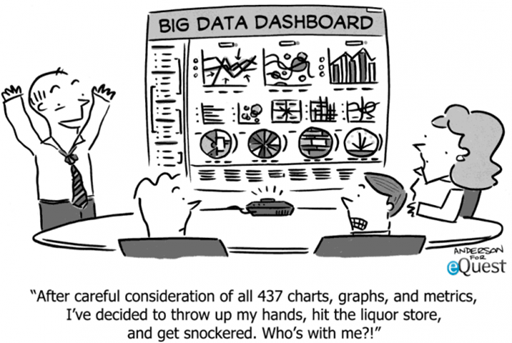“Business Intelligence” has always been a “seriously funny” phrase (oxymoron intended).
If you’ve ever had to get up for a coffee while waiting for your “real-time dashboard” to refresh, you’ve seen the irony firsthand. In many businesses, BI is fragmented, slow, and mistrusted. But when it works, it connects data to decision making and turns information into usable insight.
Last time, we built a foundation of clean, governed, connected data we called the Information Warehouse. Business Intelligence is where that foundation starts to pay off. It turns information into analysis that explains results, guides action and builds trust in the numbers before AI takes over.
The Current State of BI
According to Sigma’s 2025 State of BI Report:
- 87% of companies saw their data volumes rise last year, yet 80 % of enterprise leaders still cite a lack of real-time access as a major challenge.
- 75% or organizations surveyed say resistance to change is slowing innovation.
- 83% report siloed departments that make collaboration harder.
These impacts hit companies of all sizes:
- Small businesses struggle with affordability and patchwork tools.
- Mid-sized firms hit scalability limits.
- Large enterprises face slow performance and data trapped in silos.
These statistics show that BI is falling behind the scale and pace of modern decision making and that delays in accessing current data make it harder for teams to act quickly and perform well (Sigma).
What Modern BI Really Means
The good news is the next generation of BI is arriving fast and there are many sophisticated tools to support it. Whether you use Power BI, Tableau, IBM Cognos Analytics with Watson, Looker, or a new cloud-native platform, the direction is clear. BI is evolving from static reporting toward dynamic, AI-powered decision support.
A Forbes analysis of AI-powered BI tools describes this shift as a “new era of insights” where machine learning surfaces anomalies, generative AI summarizes trends, and users can ask questions in natural language instead of memorizing formulas. Coca-Cola, for instance, uses AI capabilities within IBM Watson to identify customer preferences and optimize product distribution in real time, ensuring every market stays stocked with what’s actually selling (Forbes).
The implication is simple: BI is no longer just the final stage of reporting. It’s becoming the foundation for intelligent, automated action.
The Characteristics of Modern BI Systems
So what defines modern BI? Five characteristics separate systems that inspire trust from those that frustrate users.
- Semantic Consistency
As we discussed in the previous article on the Information Warehouse, semantic consistency ensures every metric means the same thing everywhere. When “margin” or “churn” is defined once and used consistently, the entire organization speaks a common language. Without this, dashboards contradict each other and credibility evaporates. - Timeliness
Business decisions happen in real time, so BI must too. Modern data pipelines and APIs enable live connectivity rather than overnight refreshes. Yet according to Sigma’s survey, 81 percent of enterprises still face slow performance, showing that real time data is still not the norm. - Narrative Context
Charts and KPIs are starting points, not conclusions. The next step is explanation of “what changed, why, and what it means.” Natural-language summaries and AI-generated narratives are becoming essential, bridging the gap between data specialists and business users. - Interactivity and Collaboration
Users don’t just view dashboards, they explore them together. Drill-downs, comments, alerts, and shared workspaces turn BI from a one-way broadcast into a two-way conversation. Sigma’s research shows 37 % of executives now expect BI to support custom data apps – workflows where insight and action happen in the same space. - Explainability and Governance
Trust depends on transparency. Users must be able to trace numbers back to their logic – the lineage of data, the formula behind a metric, and who owns it. When definitions and transformations are visible, adoption soars.
The FP&A Lens
For FP&A teams, BI is the daily operating layer between accounting data and strategic decisions. It’s how analysts explain variance, build margin bridges, and deliver rolling forecasts their business partners can trust.
Finance is often the first to notice when definitions drift. If operations and finance calculate margin differently, reconciliation becomes debate. BI built on the semantic alignment of the Information Warehouse fixes that by keeping metrics consistent across the business.
Because finance already understands accountability, BI is where financial rigor meets digital agility.
AI-powered BI takes this further by removing the slow, manual work of reconciliation and reporting so teams can focus on decision support, scenario modeling, and strategy. When data updates automatically and insights are clear, FP&A teams spend less time collecting numbers and more time improving them.
Pitfalls and How to Avoid Them

Common failure modes still abound:
- Dashboard sprawl – dozens of reports, no single source of truth.
- Excel creep – manual side models bypassing governance.
- Data without decisions – insight that doesn’t drive action.
Each symptom points back to the same root cause: a BI environment disconnected from business reality. The challenge in many organizations isn’t the number of dashboards but the lack of a single version of the truth.
Best Practices to Build Trust
- Build once, share many. Curate a governed metrics layer that serves multiple tools and audiences.
- Embed BI where work happens. Whether that’s within a planning platform, a CRM, or a collaboration tool, insight belongs in context.
- Combine quantitative and qualitative insight. Commentary, annotations, and AI-generated narratives turn numbers into understanding.
- Measure adoption as a readiness test for AI. If people don’t trust the dashboard, they won’t trust the algorithm.
From Insight to Foresight
BI is not the end of the story. Once teams can trust and act on reliable insight, the next step is foresight with predictive models, scenario planning, and AI assisted forecasting that help finance plan with confidence. This is where the Next Wave continues, moving from foundation to insight to foresight, and proving that business intelligence doesn’t have to be an oxymoron.
